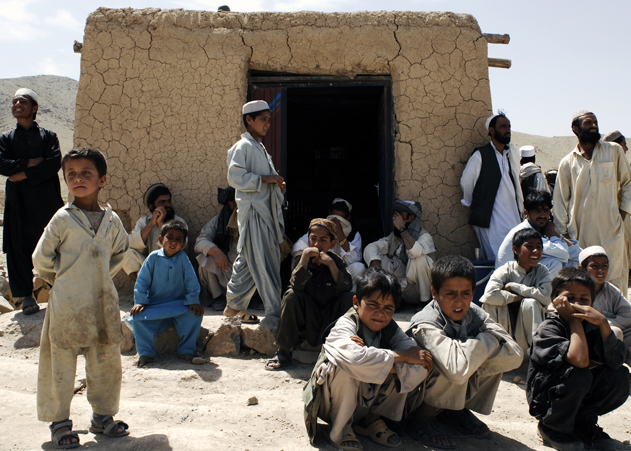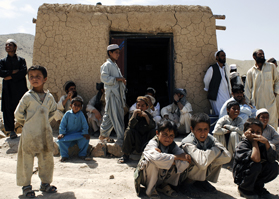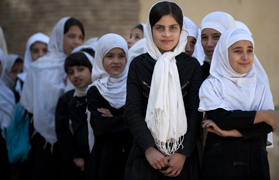Essays  Afghanistan: A nation in transition Afghanistan: A nation in transition
|
| Afghanistan: A nation in transition |

Story and Photo by G. A. Volb
Shutterjock
Back in 2008 when I touched down for the first time in Afghanistan I began spending quite a lot of time covering the coalition effort on the ground training the Afghan National Security Force -- the national army and police. The vast majority of that training was being conducted by members of the 3o-plus nations who provided trainers.
Regular visits to training centers throughout the Kabul area stressed, at the time, that in its infancy the ANSF was not prepared to provide instruction to soldiers and police by themselves. In fact, I was hard pressed to find any frontline trainers who wore the Afghan uniform. It simply wasn't a visual anyone would see regardless of the instruction being presented.
Today, however, some three years later and less than two years following the standup of NATO Training Mission-Afghanistan, the vast majority of trainers seen on ranges and in school houses are, in fact, Afghan. This is a major success story in itself as the NTM-A mission has been focused on ensuring the ANSF is self-reliant when it comes to instruction within its own ranks.
From a journalist's perspective it's actually quite difficult these days to find coalition trainers on the frontlines. It's more likely they are sitting back, observing the execution of training requirements by their Afghan counterparts and providing insight to help better professionalize delivery. This was made abundantly clear during my last trip to the Infantry Branch School in Darul Aman (Kabul). British, French and Mongolian trainers looked on as training -- planned and coordinated by Afghan officers and non-commissioned officers -- was handled without a hitch.
Again, this is less than two years since NTM-A stoodup here and as British Maj. Brian O'Neill told me as he watched SPG-9 and mortar students learning their trade, "The actual school itself has progressed quite significantly. When we arrived we were very much leading the ANA in how to conduct the practices. But now all that's happening is we're taking a monitoring stance as the instructors have really blossomed, and as a result, they conduct all the ranges by themselves and we just really take back and provide a bit of advice and try to professionalize the instructors to sort of take the weapons systems a little bit further and improve the quality of the training. It's quite impressive because some of these kandaks are over 120 strong for each weapons system, but the ANA very much organize the training by themselves, they set it up and they conduct it and then they conduct debriefs at the end before taking the students back to camp."
O'Neill, chief mentor for the heavy weapons wing at the school, had much praise for the Afghan soldiers and trainers -- and similar feedback has come my way at various other sites throughout the city. And this should not be lightly accepted as institutionalizing such training is one of the most difficult challenges any fledgling security force faces early. The fact that the ANA and ANP is doing so during an ongoing war is quite phenomenal, in my opinion. |
| |
|
|
|
|
|
|
| Please Login to see your lightbox contents
|
|
 |
|
|
|
|
By G. A. VolbShutterjock
Quite often in the Public Relations world staff is directed to turn product around immediately, the thought being that timing is everything and the faster audiences are engaged the better.
|
| Full Story >>
|
|
08/10/2014
|
|
| |
By G. A. VolbShutterjock
Folks, I'm going to fill you in on a little secret -- STRATCOMM (strategic communications) is and has always been a product of your Public Relations/Public Affairs efforts ... or should be.
It's the principle reason your organization has an internal PR/PA division, to ensure communications objectives are met. Generally speaking they exist to educate and influence target audience opinion so as to garner positive support for products, policies, "name brand" recognition, and credibility.
|
| Full Story >>
|
|
08/04/2014
|
|
| |
By G. A. VolbShutterjock
There are several media-related tools businesses and organizations use to help enhance “name brand” recognition or publicize key messages related to products, programs or services.
|
| Full Story >>
|
|
08/04/2014
|
|
| |

Afghanistan in transition
By G. A. Volb
Shutterjock
Back in 2008 when I touched down for the first time in Afghanistan I began spending quite a lot of time covering the coalition effort on the ground training the Afghan National Security Force -- the national army and police. The vast majority of that training was being conducted by members of the 3o-plus nations who provided trainers. |
| Full Story >> |
| 08/31/2014 |
|
| |

Afghans risk lives for education
By G. A. Volb
Shutterjock
KABUL, Afghanistan – The dingy-yellow structure sat 50-feet off the main highway with two stories of classrooms darkened due to a lack of light fixtures – heavily-armed guards patrolled the grounds protecting grade schoolers attending the school.
From the windows peered the faces of children, preteen and older, girls and boys, all willing to risk their lives for a better future through education. The local Afghan National Civil Order Police contingent, willing to do its part to ensure the school’s success, arrived with thousands of dollars worth of school supplies. |
| Full Story >> |
| 10/25/2014 |
|
| |
|
- Shutterjock Twitter Feed
|
|
|
|
|
|